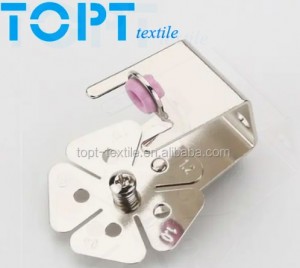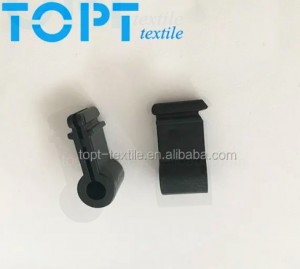Are you having trouble selecting the right Circular Knitting Machine Parts for your business? Unsure about the differences between parts and their functions? Wondering which ones offer the best performance and durability? You're not alone—many buyers face these challenges. In this article, we'll help you navigate the different types of Circular Knitting Machine Parts and make an informed choice for your business.
Common Types of Circular Knitting Machine Parts
When it comes to Circular Knitting Machine Parts, several key components play a crucial role in the smooth operation of your machines. Here are some of the most common parts you’ll encounter:
1. Cylinder: The cylinder is essential for controlling the fabric’s stitch formation and density. It determines the thickness and consistency of the fabric.
2. Dial: The dial is used to influence the stitch configuration and pattern. It works closely with the cylinder to form the fabric’s texture.
3. Needles: Needles are one of the most critical parts of the machine. They create the stitch by passing the yarn through loops to form the fabric.
4. Sinkers: Sinkers help in holding the fabric in place during the knitting process, preventing the loops from collapsing.
5. Cams: Cams are used to control the motion of the needles, ensuring accurate stitch formation.
6. Yarn Feeders: Yarn feeders guide the yarn into the machine, ensuring the proper tension for consistent stitching.
These parts play key roles in determining the efficiency and quality of your knitting machine. Understanding each part’s function will help you select the best components for your needs.

TOPT Trading’s Circular Knitting Machine Parts Categories
At TOPT Trading, we offer a wide range of Circular Knitting Machine Parts designed to meet the diverse needs of your business. Our product categories include:
1. Cylinders and Dials: Our cylinders and dials are designed for precision, ensuring high-quality fabric production with minimal downtime.
2. Needles and Sinkers: We provide high-performance needles and sinkers that guarantee optimal stitch formation and fabric quality.
3. Cams and Yarn Feeders: Our cams and yarn feeders are built for durability and accuracy, reducing maintenance costs and improving operational efficiency.
Advantages of TOPT Trading Parts: Our parts are known for their reliability, longevity, and cost-effectiveness. By choosing TOPT Trading, you gain access to high-quality parts that optimize machine performance, increase productivity, and reduce maintenance costs.
The Advantage of Circular Knitting Machine Parts
Understanding the benefits of Circular Knitting Machine Parts is crucial for making the right purchase:
1. General Advantages: High-quality parts reduce machine downtime, boost production speed, and improve fabric quality while lowering maintenance costs over time.
2. Advantages of Common Parts: Components like needles and cams ensure consistent fabric quality. Investing in quality needles and cams results in fewer defects and a higher standard of production.
3. Advantages of Brand Products: Opting for brand products from trusted suppliers like TOPT Trading comes with several added benefits. First and foremost, brand products typically offer superior material quality and are designed with advanced technology to meet the specific demands of modern textile production.
These parts are engineered with precision, ensuring they fit your machines perfectly and function efficiently, enhancing the overall performance of your equipment.

Circular Knitting Machine Parts Material Grades
The material quality of Circular Knitting Machine Parts plays a vital role in determining the machine's performance, durability, and efficiency. Choosing the right materials is not just about ensuring smooth operation; it also contributes to reducing maintenance costs and minimizing downtime. Here's a detailed look at the materials used in these critical components and the industry standards they must meet:
1. Materials for Mechanical Parts:
High-strength steel and alloys are commonly used in key mechanical components such as cylinders, cams, and needles. These materials are specifically selected for their excellent wear resistance, which is essential for parts exposed to constant friction and heavy mechanical forces.
(1)Cylinders: High-strength steel is used to maintain precision even after prolonged use. These parts must withstand intense mechanical forces without deforming or losing their shape, as precision is crucial for fabric consistency. Research shows that high-strength steel cylinders can last up to 30% longer than those made from standard materials, leading to a more consistent fabric production and fewer replacements.
(2)Cams and Needles: Hardened steel or specially engineered alloys are commonly used for these parts. The cam's function is to control the movement of the needles, and these materials ensure that the needles move smoothly without causing wear on the machine.
The use of alloy cams has been shown to reduce machine wear by 15-20% compared to standard steel, contributing to lower maintenance costs and fewer repairs.
The alloy composition reduces machine wear and guarantees consistent stitch formation, which is crucial for high-quality fabric production.
(3)Corrosion-Resistant Alloys: Certain parts, particularly those exposed to moisture, high humidity, or fluctuating temperatures, benefit from corrosion-resistant alloys. These materials help extend the lifespan of components, ensuring that they maintain performance even in challenging environmental conditions.
2. Industry Grade Standards:
Parts used in Circular Knitting Machines must meet specific industry standards to ensure they can handle the demands of mass production. Recognized standards such as ISO 9001 for quality management systems and ISO 14001 for environmental management systems provide a benchmark for manufacturing practices.
These standards help ensure that parts are made from materials that are durable, reliable, and capable of performing under stress.
(1)ISO Certifications: Parts that are ISO-certified have undergone rigorous testing for material strength, durability, and tolerance levels.
ISO-certified parts reduce operational failures by 25-30%, improving overall productivity and reducing the risk of costly downtime.
This certification ensures that the parts meet global standards for performance and safety, reducing the risk of breakdowns and defects.
For example, components like cylinders, cams, and needles are manufactured to exact specifications that ensure they meet international performance standards, resulting in consistent fabric production without frequent machine failures.
(2)Tolerances and Quality Control: Parts are also built to strict tolerance levels, ensuring a perfect fit and function. This helps reduce errors in fabric production, such as uneven stitching or irregular fabric patterns.
Parts manufactured with strict tolerance control can reduce fabric defects such as uneven stitching by 10-15%, improving the overall quality of the knitwear.
Quality control processes verify that each part meets these standards before it is sent to customers, ensuring that each part can withstand the mechanical stresses of high-speed operations.
3. Choosing the Right Materials:
Selecting the right materials for Circular Knitting Machine Parts is essential for optimal machine performance. For high-performance machines, it’s important to prioritize materials that offer superior wear resistance and long-term durability.
4. Proactive Maintenance: Choosing parts made from superior materials can also reduce overall maintenance needs. By selecting parts that are resistant to wear, corrosion, and high temperatures, you ensure that your machine runs smoothly, with fewer frequent repairs and longer intervals between replacements.
Circular Knitting Machine Parts Applications
The applications of Circular Knitting Machine Parts are highly varied, depending on the part’s function and the type of knitting machine in use. Understanding these applications is critical for making informed purchasing decisions and ensuring that the right parts are selected to meet specific production needs. Below is an in-depth overview of their uses, with some supporting data on how these parts contribute to operational success:
1. General Applications:
Circular Knitting Machine Parts are essential in the textile industry for producing a wide variety of fabrics. These include everyday garments, hosiery, technical textiles, and more specialized fabrics such as medical textiles, sportswear, and upholstery.
2. Hosiery: The hosiery industry, for example, relies on precise stitch formation and consistent yarn feeding. Parts like needles and cams are critical in achieving uniformity in knitwear, ensuring that socks or tights are comfortable and durable.
3. Garments: For garment production, especially in high-speed manufacturing, efficient yarn feeders and cams are necessary to handle a variety of yarn types, ensuring that the fabric’s texture is suitable for clothing. According to industry data, optimizing machine performance can lead to a 15%-20% increase in garment production efficiency.
4. Technical Textiles: For specialized fabrics, such as those used in industrial applications, durability and precision are crucial. The right parts, like cylinders and dials, are essential for creating fabrics that can withstand harsh environments or provide additional functionality, such as water resistance or breathability.
In conclusion, choosing the correct Circular Knitting Machine Parts is essential for achieving the highest fabric quality, minimizing machine downtime, and improving production efficiency.
By relying on TOPT Trading's trusted parts, businesses can enhance their competitive edge in the textile industry, ensuring reliable, long-lasting performance and cost-effective manufacturing.
Post time: Jun-23-2025
